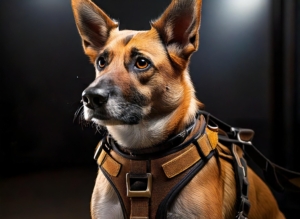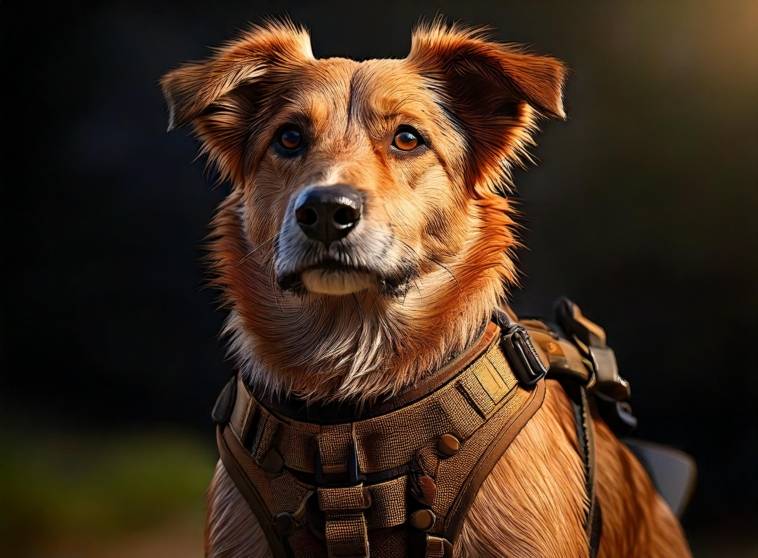Here’s an overview:
Why Choosing a Dog Harness is an Important Decision to Make
Classification of Harnesses and Their Use
Material and Durability considerations
How Different Brands and Models Compare
Step by Step Approach on How to Fit a Dog Harness
Pros and Cons of Various Types
Common mistakes that everyone seems to be doing
Conclusion: Final Tips on Choosing The Best Dog Harness
Introduction to Dog Harnesses
Like leashes, dog harnesses are very useful when you need to pull or control your dog’s movements. Nevertheless, they have several advantages over collars since harnesses are much more comfortable and do not concentrate pressure on one particular area of a dog’s neck. Moreover, they are necessary for dogs with breathing difficulties or injured necks. Below are some pointers to consider when selecting a harness:
- Material: Lightweight mesh or nylon is always the best choice.
- Design: Comfort is key, choose designs that come with padding and adjustable straps.
Type:
- Back-clip: Best suited for well-behaved small dogs.
- Front-clip: Designed to aid in training and reducing dog pulling.
- Dual-clip: Makes it possible to use the harness for different activities at any given time.
- Size and fit: Choose a harness that fits well, but does not restrict movement.
Why Choosing a Dog Harness is an Important Decision to Make
Making a proper choice in regards to a dog harness will help with the dog’s safety and convenience. An improper harness can have the following consequences:
- Inhibition in movement
- Breathing challenges since there’s pressure around the chest and neck area
- Structure discomfort caused by abrasion
Selecting a harness that is appropriate for the dog’s size, breed, and activity level can help avoid these problems from happening. Look at other things like the material, adjustability of the harness, as well as how it fastens. A good harness can make walks go smoother, and help train the dog more effectively while at the same time ensuring safety. When chosen properly, it ensures a more enjoyable and healthy outing.
Classification of Harnesses and Their Use
Back-Clip Harness:
A back-clip harness has a D-ring that is attached at the top of the dog’s back. It’s very easy to work with dogs with a calm demeanor.
Front-Clip Harness:
A front-clip harness has D-ring that is located in the chest region. Best for dogs that tend to pull while being taken out on a leash.
Dual-Clip Harness:
A dual-clip harness has both front and back attachment points. For greater flexibility, it has the qualities of both kinds.
Step-in fits all Harness:
A step-in harness is made in such a way that the dog has to step in, followed by security with the buckle. It is also suitable for any dogs that do not enjoy having some apparatus put on their heads.
Vest Harness:
A vest harness provides a larger area coverage and may have some cushioning. It is also recommended for small dogs or dogs requiring extra support.
Material and Durability considerations
The material of the dog harness has a direct impact on the level of comfort and the longevity of the harness itself. Choose from the materials listed below;
- Nylon: Very strong material, can be used in any type of weather, comes in a wide range of colors.
- Polyester: Moderately thick and padded to enhance the comfort when in use.
- Leather: Tough and aesthetically pleasing but needs care regularly.
- Mesh: Light texture, often allows ventilation which is good in hot weather, but may be weak overall.
You may also consider the following:
- Strength: Tightly sewn cross stitching should be visible.
- Hardware: Metal buckles are more durable than plastic ones.
- Padding: Protects from rubbing and discomfort.
- Flexibility: A mechanism for sizing to fit the user exactly.
Sizing and fitting guideline
It is important to take the right size of the dog harness to allow for comfort and safety in the dog. This is how you do it when fitting and measuring a harness:
- Measure your dog Use a soft tape measure.
- Keep the tape measure in starting position at the bottom of the neck area.
- Chest Measurement: Recorded at the level around the upper chest when the dog is standing.
- Comparative Sizing: Ensure all measurements are in correlation with the size chart provided by the manufacturer.
- Strap Size: Harness worn should be strap adjustable.
- Sizing: Should conform again to not be over-tightened but also moderately firm.
- Thighs Fitting Rule: Straps should be such that two fingers can be slid through underneath.
The overall experience would also be ideal as there are no discomfort or chances of escape.

Additional Features
Besides what was previously mentioned, features of the special kind may enhance the usability and comfort of the harness.
- Fixing Clips: Can be adjusted to suit a particular size of dog.
- Grip: Helps in controlling the dog better; also comes in handy when the dog needs to be lifted.
- Reflectors: For good visibility in the dark.
- Chest Frame: Soft cushioned frames for more comfort, in order to stop chafing the skin.
- Mesh Material: Breathable material for the dog to stay comfortable even after so many hours.
- Attachment Points: To allow for different angles when fighting for leash control.
- Simple Structure: Should be easy to put on and off the harness.
- Quality: High-quality material to make it hard wearing.
How Different Brands and Models Compare
In comparing several brands and models of the dog harnesses, one should look at the quality of the material, adjustability and design features available. Popular brands such as Ruffwear, Kurgo, and Julius-K9 have different models that are suited for specific purposes:
- Ruffwear: Producing models that are both durable and comfortable. The Front Range and Web Master models have padded chest plates and multiple attachment points.
- Kurgo: Safety and convenience are key features. Tru-Fit is crash tested and can be used for car rides.
- Julius-K9: There are many customizable interchangeable patch options. For working dogs, rugged IDC Powerharness are suitable.
For best results, choose what is appropriate for your dog’s size, behavior, and needs.
Step by Step Approach on How to Fit a Dog Harness
A good fitting for a dog harness guarantees safety and comfort of the dog. Follow these steps:
- Measure the Dog: First use a tape measure to measure the girth and neck circumference.
- Check Size Chart: Ensure you check the manufacturer’s size chart as a reference.
- Adjust Straps: In this case, all straps should be adjusted to be snug but not tight around the bust.
- Position Harness: Make sure the harness fits over the chest and back.
- Two-Finger Rule: The last step is to check meassure two fingers between the harness and the dog’s skin.
- Test Movement: Walk the dog to see how easy or difficult it may be for them to move.
Pros and Cons of Various Types
Nylon Harness:
- Pros: Very durable, low-cost, lightweight, easy maintenance
- Cons: Can cause chafing, not good for pullers
Mesh Harness:
- Pros: Comfortable, good ventilation, good for small breeds, reduces strains
- Cons: More prone to tearing, difficult to wash, would not recommend for strong pullers
Leather Harness:
- Pros: Such eye candy, really tough and hard to break, ouchies safe for strong pullers.
- Cons: Very expensive, Quite heavy, Needs regular care
No-Pull Harness:
- Pros: Greatly decrease pulling ability, Great for control, Great for training purposes
- Cons: Does restrict them, can be uncomfortable when placed wrong
Vest Harness:
- Pros: Provides added support, spreads weight across the harness evenly, securely attaches items.
- Cons: Quite bulky, might make him feel a little warm, Little difficult to strap on
Front-Clip Harness:
- Pros: Highly effective in reducing pull, This also makes it easier to handle them, Great for training
- Cons: They can irritate the dog, There is a chance of causing chafing as well
Common mistakes that everyone seems to be doing
- Horses for Courses!: This is perhaps the worst mistake that many owners make. Most of them get either Smaller (too tight) or Larger (too Loose) harnesses for their dogs which causes discomfort or high risks of escape.
- No leash for the Dunce: And finally, one of the worst aspects of choosing a harness that non-barking dogs tend to pull, and together with lazy bastards, they certainly do have issues.
- Ignoring Material Quality: A harness is made from cheap materials that could easily break or annoy the skin of the dog.
- Not Fitting Properly: The incorrect fitting of the harness, which causes it to rub or fall off.
- Safety Features Not Being Considered: Straps are without reflectors or with weak harness buckles, putting the dog at the risk.
Frequently Asked Questions
What are the procedures of measuring a dog so that You can use the harness?
Take the measurement of the chest region girth, neck region girth as well as considering weight in order to get the right fit.
Explain the difference between the back-clip harness and the front-clip harness.
Leash attachment is on the dog’s back in a back-clip harness. A front clip has the attachment on the chest.
Is there any additional advantage of using a harness in comparison to the use of a collar?
A harness can create control as well as safely redistribute pressure.
How often do harnesses need to be changed?
Change a harness that is worn out, damaged or that I have outgrown.
Conclusion: Final Tips on Choosing The Best Dog Harness
When buying a dog harness make sure to relate the size, breed, and behavior of the dog.
- Measurement: Extrapolate support outer sizes especially the chest and the neck.
- Material: Search for something that is robust and at the same time breathable.
- Adjustability: Purchase harnesses with several adjustment points.
- Type of Harness: Front-clip is good for restraint; back-clip is good for walking; dual-clip is good for all purposes.
- Padding: Look for sufficient padding to make sure of comfort.
- Ease of Use: Inspect the ease of putting on and taking off the harness.
- Safety Features: Reflective strips and heavy buckles are extremely important.
Inspect the harnesses periodically to check for damage to ensure the user’s safety and comfort.
Article by: Tawab Sukhera (Ethologist)




